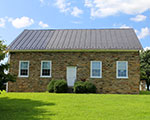The Historic Churches of Ebenezer Cemetery

The Ebenezer Cemetery and Baptist Churches were placed on the National Register of Historic Places on June 3, 1994, file #053-0140. http://www.dhr.virginia.gov/registers/Counties/Loudoun/053-0140_Ebenezer_Churches_1994_Final_Nomination.pdf.
The following historical information is excerpted from the supporting documents.
Today, both the Old Church and the New Church and the two cemeteries on the site are owned and maintained by the nondenominational Ebenezer Cemetery Company, Inc. The family of James (Jim) Walsh had lived on the Old Butcher Plantation for over 100 years. In 1971 Jim Walsh, President of Ebenezer Cemetery Company and the Board of Directors began a 10-year restoration of the churches. Melvin “Bunny” Allder, Truman Hawes Jr. and Louis Underwood were the main carpenters. Jim Walsh laid the new floor of Old Ebenezer. John Virgil Santmyer electrified the old church, and his son, John Santmyer Jr., put electric heat in the new church. All the workers volunteered their time or labored for pennies. The property is a beautifully preserved example of days gone by. The cemetery is exceptionally well kept, organized, and documented. In fact, just outside the front door of the “new” church is a bulletin board with a plot map. The churches are used for services annually, as well as for funerals and weddings.
 The Old Ebenezer Church, earlier referred to as Butcher’s Meeting House or the Ebenezer Meeting House, may have been built before 1769 on land owned by Samuel Butcher, Sr. His will of September 12, 1769, gives two acres of his land for the use of “the Baptist Meeting House and School House,” describing those two acres as “the same that the Meeting House is now built upon.” This is the small stone church seen in the pictures. To the left of the stone church is the “old” cemetery with many very old headstones.
The Old Ebenezer Church, earlier referred to as Butcher’s Meeting House or the Ebenezer Meeting House, may have been built before 1769 on land owned by Samuel Butcher, Sr. His will of September 12, 1769, gives two acres of his land for the use of “the Baptist Meeting House and School House,” describing those two acres as “the same that the Meeting House is now built upon.” This is the small stone church seen in the pictures. To the left of the stone church is the “old” cemetery with many very old headstones.
Nine members of the Goose Creek Baptist Church and eight members of the Ketoctin Baptist Church organized Ebenezer Baptist Church in 1804, having been dismissed from their congregations for the sole purpose of constituting a new congregation.
Beginning in the 1830s, differences in philosophy began to divide many Baptist congregations in Virginia. Church leaders and members were divided in thought concerning the appropriateness of Sunday Schools, instrumental music in the worship service, reform and missionary movements, and Bible Societies. Congregations accepting these new ideas and practices and favoring more independence of members were referred to as New School Baptists those rejecting them were referred to as “Old School” or Primitive Baptists because they adhered only to what they believed to be the practices of the primitive church, or the church as described in the Bible.
By 1834 the congregation had split into these two camps, but both continued to use the church. These events explain the language used by Samuel Butcher, Jr. in January 1834 when he deeded the Meeting House property to the Trustees of the Ebenezer Meeting House. The indenture includes the following guidance:
“inasmuch as difference of sentiment amongst the Baptists, have arisen, which ought not to be the cause of separation between Brethren, it is not intended that one party so differing in sentiment shall use and enjoy the property herein conveyed to the exclusion of the other party, but the said Trustees are hereby authorized to permit any party of Baptists whom they consider of good order and good Standing in the society, to use and enjoy the said property for the purpose of Worship, provided that no party shall have the exclusive privilege of the house more than two Lords days in the Month.”
Apparently, both Old School and New School Baptist congregations used the Ebenezer Meeting House until about 1855. Around 1855 a church for the New School Congregation was built immediately adjacent to the old church. The New Ebenezer Church was built on three-quarters of an acre of land deeded by William Galleher and his wife to trustees for the Ebenezer Church (New School Baptist) in September 1855. The exact date of construction is not known but the building’s Greek Revival style suggests a date not much later than 1855.
It is estimated that worship services were no longer being held in the Old Church by the early 1900s and it is believed that by 1941 worship services were no longer being held in the New Church. The current Ebenezer Cemetery Company, Inc. was re-incorporated in December 1959 to care for the two cemeteries and both of the churches.
